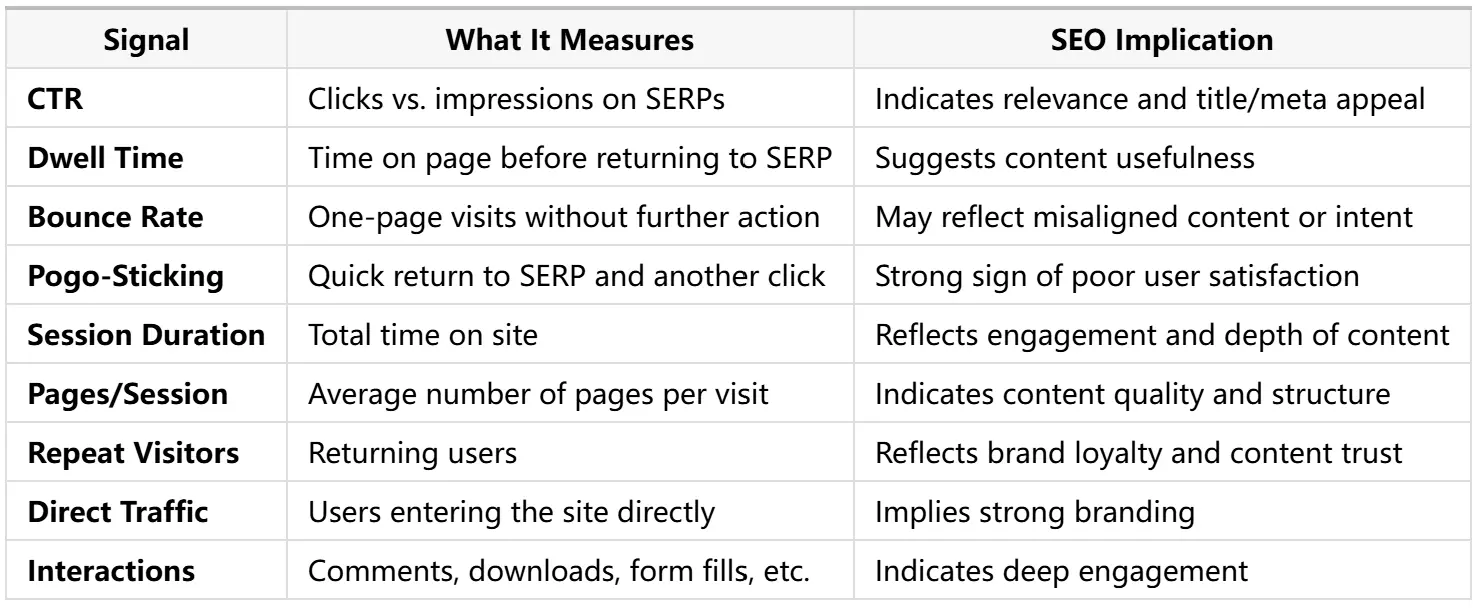9 User Behavior Metrics That Impact SEO: A Complete Guide
Instruction
User behavio signals such as Click-Through Rate (CTR), Dwell Time, Bounce Rate, and others play a critical role in how Google assesses user satisfaction. Although not direct ranking factors, these signals strongly correlate with better rankings because they help Google align its results with user intent. Enhancing these metrics improves both your SEO performance and the overall experience your visitors have on your site.
What Are User behavior signals in SEO?
Google’s mission is to deliver the most accurate, helpful, and satisfying content to users. To do this effectively, it evaluates how users interact with web pages. These behavioral metrics are called user engagement signals.
These signals offer insight into how well a page satisfies user needs. They help Google refine its ranking algorithms to ensure that top-ranking pages offer genuine value. While the precise role of these signals in rankings is not publicly confirmed, SEO professionals widely agree on their influence.
Key User Engagement Signals and Their SEO Impact
1. Click-Through Rate (CTR)
CTR measures the ratio of clicks to impressions on search engine results pages (SERPs). A high CTR shows:
Your meta title and description are engaging
Your result aligns with user intent
Google may rank your content higher due to perceived relevance
Improve CTR by using strong calls to action, incorporating target keywords naturally, and addressing user intent directly in your snippets.
2. Dwell Time
Dwell time is the duration a user stays on your page before returning to the SERP. Longer dwell times typically indicate:
Your content is engaging and informative
Users are exploring the content fully
Your page experience supports sustained attention
Boost dwell time by structuring content for readability, offering key insights early, and embedding engaging multimedia.
3. Bounce Rate
Bounce rate represents the percentage of users who leave your site after viewing only one page. A high bounce rate may imply:
The content does not match user expectations
The site design or UX is lacking
Load times or mobile compatibility issues exist
Context matters—informational pages may have high bounce rates while still fulfilling user needs.
4. Pogo-Sticking
This occurs when a user clicks a search result, quickly returns to the SERP, and clicks another result. It suggests:
Poor alignment with search intent
Thin or misleading content
Subpar first impressions
Minimize pogo-sticking by delivering clear, immediate value and ensuring your content is well-aligned with the query.
5. Time on Site (Session Duration)
This measures the total time users spend on your website in one session. Longer durations imply:
Content depth and quality
Effective internal linking
Engaging multimedia and storytelling
Use related links, recommended reading, and structured content to encourage extended browsing.
6. Pages per Session
This indicates how many pages a user visits in one session. Higher figures often reflect:
Effective navigation and linking strategy
A wide breadth of useful content
A satisfying user experience
This metric is especially important for blogs, knowledge bases, and e-commerce platforms.
7. Repeat Visitors
Returning visitors signal trust and long-term value. They indicate:
Authority in your niche
Strong brand recognition
High-quality, bookmark-worthy content
Maintain audience engagement with regular content updates and email campaigns.
8. Direct Traffic
Direct traffic reflects users typing your URL or using a saved bookmark. It shows:
High brand awareness
Positive offline marketing impact
Consistent user interest
Direct traffic can indirectly enhance SEO by building domain authority and credibility.
9. Site Interactions
Interactions such as clicking buttons, submitting forms, watching videos, or commenting show:
Deep engagement with content
User interest and participation
Active conversion behavior
Interactive elements like polls, calculators, and embedded tools improve UX and reflect genuine user attention.
Visual Summary Table

How Google Interprets These Signals
Google collects and analyzes anonymized behavioral data across billions of search queries to understand which results satisfy user needs best. These signals help:
Refine machine learning models
Promote helpful content
Suppress low-value or misleading pages
While Google does not use Google Analytics data directly for rankings, it relies on data from its own ecosystem—Chrome, Android, and Search—to assess engagement trends.
Strategies to Improve User Engagement (and SEO)
Create High-Quality, Relevant Content
Understand searcher intent and answer questions clearly
Use structured formatting and storytelling
Keep content current with timely updates
Optimize Titles and Meta Descriptions
Use compelling language that teases benefits
Naturally include target keywords
Align snippet messaging with page content
Enhance User Experience (UX)
Make navigation intuitive and mobile-friendly
Use whitespace and visual hierarchy
Eliminate intrusive popups and distractions
Improve Site Speed
Compress images and leverage caching
Use content delivery networks (CDNs)
Optimize server response time
Use Engaging Multimedia
Add explainer videos and GIFs
Design shareable infographics
Use charts and illustrations to simplify data
Format Content for Readability
Use short paragraphs and bulleted lists
Include H2 and H3 subheadings for scannability
Highlight key takeaways with bold or blockquotes
Encourage Interaction
Include comment sections and Q&A prompts
Embed tools, calculators, or quizzes
Add CTAs for shares, downloads, or subscriptions
Build a Recognizable Brand
Use consistent design and messaging
Foster a presence on social platforms
Get featured in industry publications
Keep Content Updated
Revise outdated facts and statistics
Expand thin pages with more depth
Consolidate or redirect underperforming content
Final Thoughts
User engagement metrics reflect how real people experience your site. When users stay longer, interact more, and return frequently, it signals trust and satisfaction to Google. While these signals aren’t direct ranking factors, they align closely with Google’s goal of surfacing the best possible content.
Focus on creating exceptional content and delivering a seamless, engaging user experience. In doing so, you improve not only your rankings but also the value you offer to every visitor.